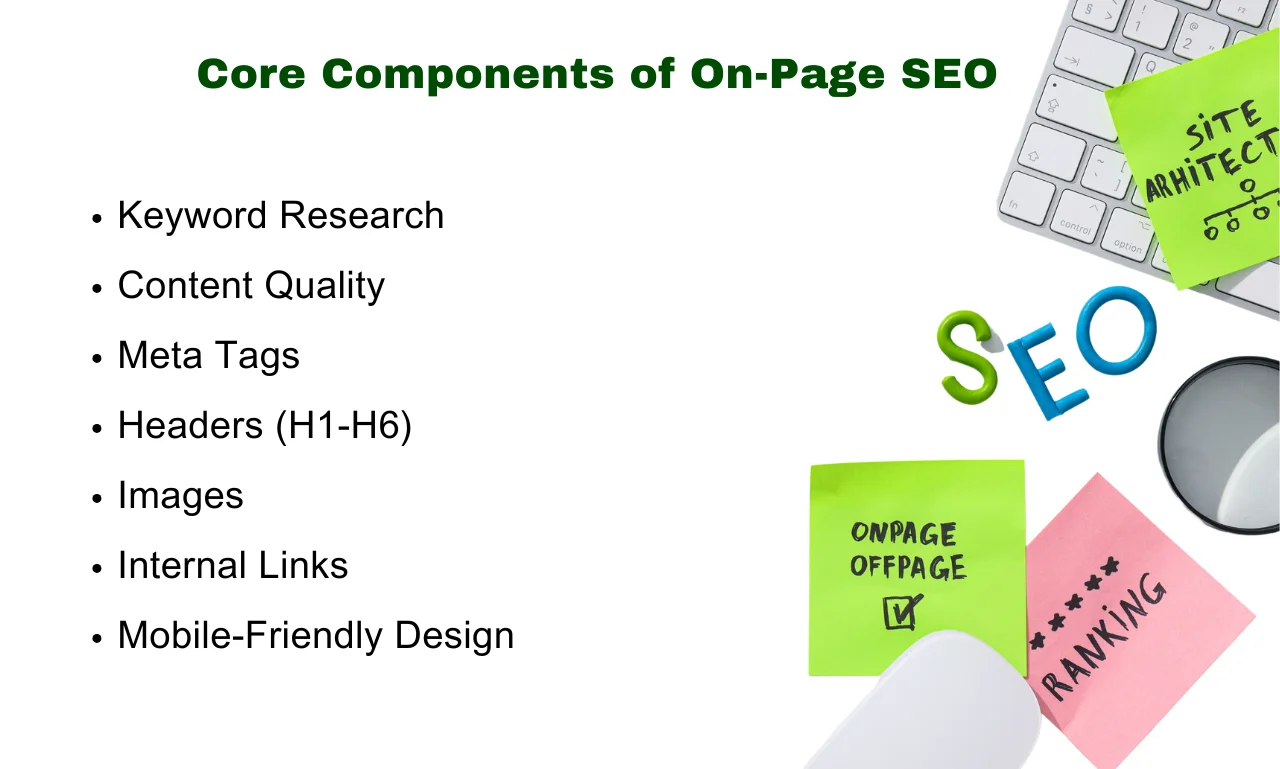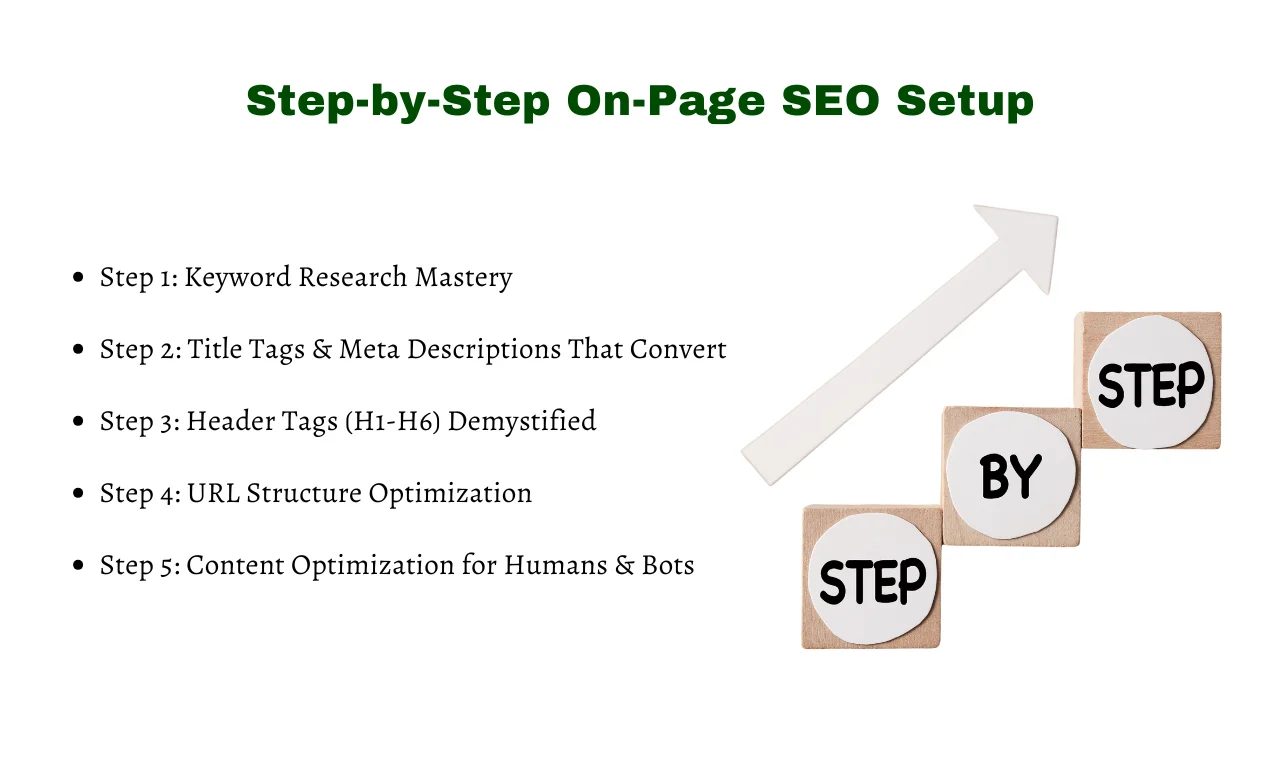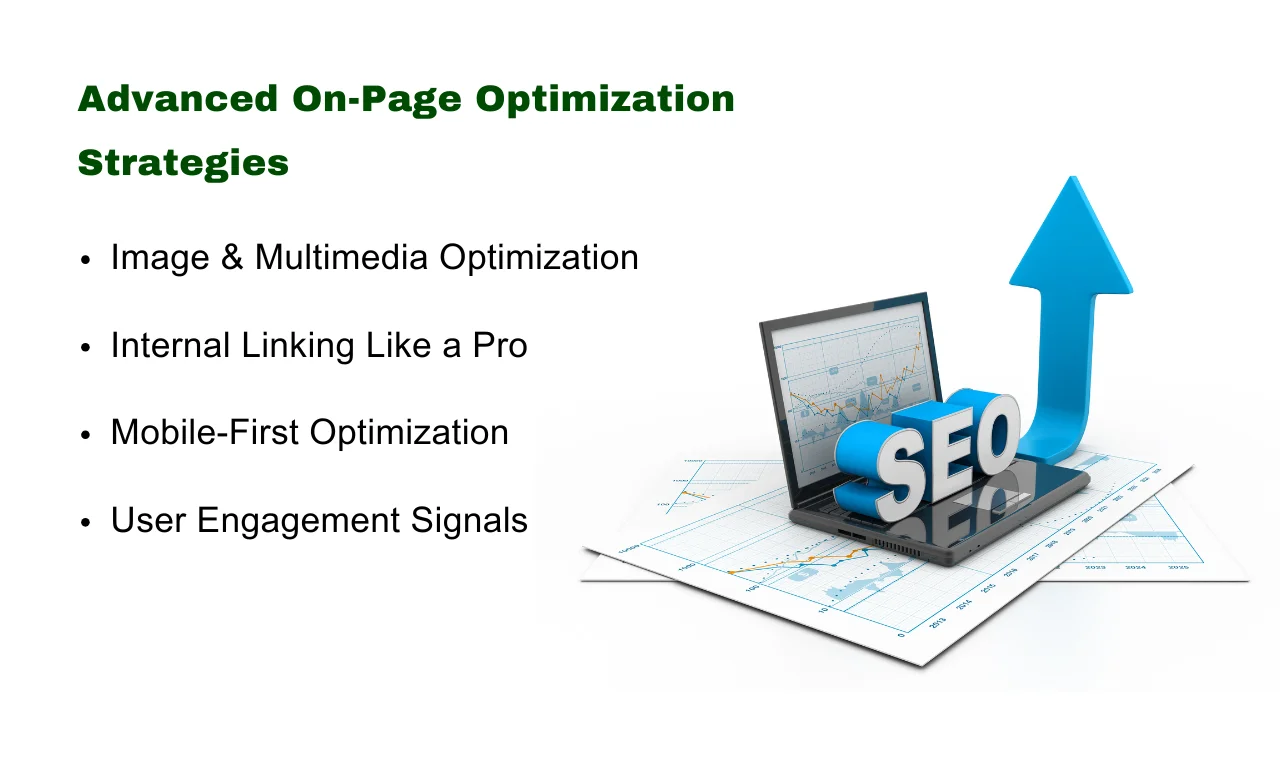Your website operates like a retail store. On-page SEO works similarly to how you organize and advertise your store items while teaching employees to assist buyers during their shopping journey. On-page SEO will make your website content and page setup work better to get higher search engine results.
But why does this matter in 2025? Simple: 81% of shoppers research online before buying (BrightLocal). Without optimization, your website will stay hidden from search engine users. Let’s break down what on-page SEO involves, why it’s non-negotiable, and how to master it.
On-Page vs. Off-Page vs. Technical SEO: What’s the Difference?
- On-Page SEO: Are you wondering what is on page SEO optimization? It refers to all elements you manage directly on your website like content and component structure.
- Off-Page SEO: External factors (backlinks, social shares).
- Technical SEO: Behind-the-scenes fixes (site speed, mobile-friendliness).
Think of these three aspects of SEO like baking a cake. On-page SEO is the recipe, off-page is the reviews, and technical SEO is your oven. All three matter, but here today, we will focus more on the recipe.
Why Is On-Page SEO Essential in 2024?
Google now gives more priority and top ranking to user satisfaction. Your website must be excellent and fast to load while working well on mobile to meet the requirements of search engines. When a website works very smoothly on a mobile device, it has a 62% chance to appear first on search results according to HubSpot. Without good on-page SEO, you will lose website visitors who will become potential customers in the future.
Core Components of On-Page SEO (Checklist)
This interactive checklist shows you how to dominate on-page SEO today:

- Keyword Research: Your search for the right keywords should focus on phrases that have high volume but weak competition.
- Content Quality: Create content that helps people solve their issues and reply to their queries while keeping readers focused.
- Meta Tags: Write compelling titles and descriptions.
- Headers (H1-H6): Structure content for readability.
- Images: Optimize file names, alt text, and size.
- Internal Links: Guide users to related content.
- Mobile-Friendly Design: Ensure smooth mobile experiences.
Pro Tip: Use infographics as your guide for free to see how these steps work.
Step-by-Step On-Page SEO Setup

Step 1: Keyword Research Mastery
Begin by selecting keywords that your target audience uses to search, but make sure the competition is moderate on these keywords. The tools like Ahrefs and Ubersuggest can prove helpful regarding keyword research. For example, instead of opting for “SEO” a better strategy would be to go for “on-page SEO checklist for beginners” because this specific keyword combination has less competition.
Next, analyze search intent. Determine the specific aim of the user, whether they want to purchase, gain knowledge, or make comparisons. Ask:
Is the user looking to buy, learn, or compare?
If your page about “best running shoes” targets informational intent (reviews) but Google sees commercial intent (product pages), you’ll struggle to rank. Match your content to the intent.
Step 2: Title Tags & Meta Descriptions That Convert
The title tag sets the initial impact on users. Keep your title tags under 60 characters to prevent truncation issues. For example:
- Weak: “Guide to SEO”
- Strong: “On-Page SEO Guide: Boost Rankings in 2024 (7 Easy Steps)”
This title shows How to Enhance Your Online Performance Effectively. Your Meta description should kick the curiosity level. Moreover, your Meta Description and Meta Title invite users to take action.
- “Learn how to master on-page SEO with actionable tips. Start climbing Google’s rankings today!”
Mobile Tip: Program your AMP pages to adjust the title display when people view them on mobile devices.
Step 3: Header Tags (H1-H6)
- H1: Use one H1 per page (e.g., your blog title).
- H2: Break sections into subs (e.g., “Keyword Research Tips”).
- H3-H6: Organize deeper details (e.g., “Tools for Finding Keywords”).
Headers not only improve the readability of content but also help Google understand your content.
Step 4: URL Structure Optimization
Try to keep URLs short, descriptive, and keyword-rich. For example:
- Messy: yoursite.com/blog?id=123
- Clean: yoursite.com/on-page-SEO-guide
Use Screaming Frog to find and repair damaged website connections. When users encounter broken links, they struggle to navigate your site, while damaging your SEO performance.
Step 5: Content Optimization for Humans & Bots
Your content quality needs the 5 main pillars to succeed, which are as follows:
- Depth: Cover topics thoroughly.
- Originality: Offer unique insights.
- Readability: Use short sentences and paragraphs.
- Engagement: Add visuals, examples, and stories.
- Value: Solve a problem or answer a question.
Add LSI keywords like “SEO optimization tips” and “search engine ranking factors” in a meaningful way. Al, so try to avoid stuffing because Google penalizes forced keywords.
Advanced On-Page Optimization Strategies
Let’s understand some advanced methods that help you beat the competition while dominating search results. If you want to get quick results, then you should use these proven methods for search engine optimization preparation in 2025.

Image & Multimedia Optimization: Beyond Alt Text
Many people believe images exist only to make pages look better but they are much more valuable. Think again. From enhancing visuals to creating better user connections and faster page loading which helps Google better recognize your content, everything is done by high quality images. Here’s how to do it right.
Compressing Images Without Losing Quality
53% of visitors leave pages during 3 seconds of web page loading delay (Portent). Here are some tools you can apply to reduce file sizes while maintaining good-quality results.
- ShortPixel: Compresses images to 70% smaller sizes automatically.
- Squoosh: A free Google-made tool that manual optimization experts can use without programming skills.
Example: The 1MB banner image reduces to 150KB using ShortPixel’s service. That’s an 85% reduction! Faster load times = happier users + higher search engine rankings.
Video SEO Best Practices
According to HubSpot research, text pages receive half the organic views in comparison to what video content attracts. To optimize video content, you need to enhance it through these steps.:
- Add Transcripts: Use Ai To Turn Audios into Text for Search Engines.
- Optimize Titles: Insert video SEO keywords straight into the title text, for example,e “2024 SEO Trends Video Guide”.
- Use Schema Markup: Implement Schema Markup to display detailed search results to Google.
Pro Tip: Post your videos on YouTube for exposure and display them directly on your website to help users stay active on your platform.
Internal Linking Like A Pro: The Secret to Site Authority
Internal links allow users to discover connected content while passing SEO effectiveness throughout your website. But most people do it wrong. Here’s how to ace it.
The “Hub and Spoke” Model
Build a main guide page (Hub) as your base while designing separate connected pages (Spoke) focused on their specific topics. For example:
- Hub: “Ultimate Digital Marketing Guide”
- Spokes: “On-Page SEO Tips,” “PPC Advertising Basics,” “Social Media Marketing Strategies”
The proper linkage structure enables user engagement, reduces bounce rates, and proves effective in terms of ranking and visibility.
Anchor Text Diversity
Using the same description when linking to content appears as spam to search engines. Mix it up:
- Exact Match: “on-page SEO checklist”
- Partial MatchImproveove your SEO”
- Branded: “Three Angle MarketingGuideide”
- Generic: “click here”
Example: Connect your SEO service page to different sections using anchor text including “rankings enhancement” and “consult our local SEO team.”
Mobile-First Optimization: Google’s #1 Priority
According to Statista data, Google receives more than 60 percent of its daily search inquiries from mobile phones. A non-mobile-friendly website makes you undetectable to Google. Let’s fix that.
Accelerated Mobile Pages (AMP): Pros and Cons
AMP provides fast website loading on mobile devices but has some important disadvantages.
- Pros: Blazing speed and better mobile rankings.
- Cons: Limited design control and no JavaScript.
Verdict: AMP works best for speedy news and blog content but not heavy product pages on e-commerce websites.
Responsive Design Checks
Check your website’s mobile readiness through Google’s Mobile-Friendly Test. You can rely on different tools to scan your website for problems that include all crucial items.:
- Text too small to read
- Clickable elements too close
- Unplayable content
Google monitors how users use your website features. High engagement = higher rankings. Let’s unlock this secret weapon.
User Engagement Signals: Make Google LOVE Your Site
Google tracks how users interact with your site. High engagement = higher rankings. Let’s unlock this secret weapon.
Reducing Bounce Rate with Better Content
Most visitors who visit your website but leave quickly show that your content needs improvement. Change your content type to create interactive components.
- Quizzes: (What’s Your SEO Score?)
- Calculators: (ROI Calculator for PPC Ads)
- Polls: (Which SEO tactic works best for you?)
Optimizing for Dwell Time
Dwell time = minutes users spend on your page. Here are some factors you can consider to boost it up:
- Bullet Points: Skimmable lists.
- Subheaders: Break text into digestible chunks.
- Visuals: Charts, infographics, and memes.
Example: A user spends three times longer time reading a 2000-word blog with ten subheaders and five visuals instead of standard text.
Putting It All Together: Your Action Plan
- Audit Images: Compress all images above 200KB.
- Link Smartly: Place 3 to 5 essential links within your blog post and use different anchor texts to connect between web pages.
- Test Mobile: Use Google’s Mobile-Friendly Test tool every month to test mobile compatibility.
- Engage Users: Include a single interactive part on your major 5 pages to improve user interaction.
Advanced On-Page Tactics for Seasoned Marketers:
Ready to level up? There are many effective on-page SEO practices that experienced marketers often overlook. By using schema markup and AI tools, you can protect your site from the future and become more successful than your market competition. Let’s dive into those practices:
Schema Markup Deep Dive: Speak Google’s Language
Google reads schema markup as a special code that shows precisely the meaning of your content. When you implement schema markup correctly you will achieve search results with extra details as well as take the lead in voice searching and rank higher in search engines.
Product Schema for E-Commerce
Product schema improves simple product pages with attractive search result enhancement features. Google emphasizes the following details with marked-up content.
- Price
- Availability
- Star ratings
- SKU numbers
Example:
A product page for “Wireless Headphones” with 4.8-star ratings above its product page along with availability status “In Stock” shows more promising results.
How to Implement It?
- Use Structured Data Markup Helper from Google.
- Plugin products with name labels and print details including sales information.
- Check your results using Google’s Rich Results Test platform.
Pro Tip: Whenever possible, include the Aggregate Rating schema to show star ratings. According to BrightLocal research 35% more users click on websites when they have product reviews displayed.
How-To Schema for Tutorials?
Your step-by-step instructional material serves as featured snippets through the how-to schema format. The search results feature “How to Optimize On-Page SEO” guide can be listed at the top of results with a step-by-step approach.
Steps to Add How-To Schema:
- Visit Schema.org’s How-To guide.
- Define each step with the attribute name and text.
- Include estimated costs and tools.
Case Study: By following how-to schema implementation, a blog can receive 90% more website visitors.
Voice Search Optimization: Win the “No-Click” Game
Statistics reveal that 40% of U.S. adults conduct voice searches each day (Statista). By adapting your content for voice technology, you will receive more visitors than your rivals.
Answering “People Also Ask” Questions
Voice searches directly mimic the questions found under “People Also Ask” on Google. For example:
- Query: “What’s the first step in on-page SEO?”
- Optimize: Create a section titled “Step 1: Keyword Research” with a clear, concise answer.
How to Find PAA Questions:
- Type your keyword into Google.
- Scroll to the “People Also Ask” section.
- Answer these questions in your content using H2/H3 headers.
Pro Tip: To find PAA questions, you can also use AlsoAsked.com as a tool to generate lists of related questions quickly.
Conversational Keywords
People use voice search in longer natural sequences. Target phrases like:
- How do I start with on-page SEO?
- What’s the best tool for SEO optimization?
Tools to Find Conversational Keywords:
- AnswerThePublic: Visualizes questions people ask about your topic.
- SEMrush’s Voice Search Report: Identifies long-tail keywords with voice search potential.
Example: For “on-page SEO,” AnswerThePublic might reveal queries like “Why is on-page SEO important for small businesses?”
AI-Driven On-Page SEO: Work Smarter, Not Harder
Are you thinkinof usingse ai for on-page seo? AI systems decrease SEO task time while making the outcomes better. You can effectively put these on-page SEO tools to work through proper ethical implementation.
Use ChatGPT for Content Ideation:
Stuck on ideas? With ChatGPT users can receive topic suggestions, plus draft paragraph drafts, plus meta description text.
Prompt Example:
“Generate 10 blog titles about on-page SEO for beginners.”
Output:
- “On-Page SEO 101: A Beginner’s Guide to Ranking Higher in 2024”
- “7 Simple On-Page SEO Fixes You Can Do Today”
- “How to Master On-Page SEO Without Hiring an Expert”
Pro Tip: Take AI suggestions and modify them to make results original. Integrate results from your targeted industry into the text changes.
AI Tools for Meta Descriptions
You can use tools like Frase and SurferSEO for meta descriptions that boost website visits.
How to Use Them:
- Enter your target keyword (e.g., “Digital Marketing Agency Dubai”).
- These tools will examine the meta descriptions used by other websites in your market.
- It creates a data-informed output by merging keywords with persuasive elements.
Example:
- Before: “Learn about SEO optimization tips.”
- After: “Discover 2025’s Top SEO Optimization Hacks (Backed by 1,000+ Case Studies).”
Warning: Try never to copy AI content verbatim because Google will penalize low-quality and automated text.
Putting It All Together: Your 2024 Action Plan
- Implement Schema: Insert product or step-by-step schema markup into three important web pages every week.
- Target Voice Search: Optimize one blog for PAA questions and conversational keywords.
- Test AI Tools: Put ChatGPT to work by generating 10 on page seo content concepts and modify them afterward.
6. FAQs About On-Page SEO
How long does it take to see results from on-page SEO?
How fast on-page SEO impacts search ranking results depends on many things.
A typical improvement in rankings for highly contested keywords may take 3 to 6 months. Title tag, meta description, and content changes drove a 40% growth in traffic over four months. The length of time to achieve results depends on domain authority strength and industry competition, plus content quality.
Does on-page SEO work for multilingual sites?
Yes! A multilingual website needs effective on-page search engine optimization methods to succeed online. When you add hreflang tags to your site, search engines will display the appropriate language version to your users. Making content match local search terms helps each audience group find results that suit their needs.
Can I over-optimize my on-page SEO?
You will damage your search engine position when you optimize content too much. Website rank suffers when you repeat keywords too much or use fake links inside your site and excessively match keyword designs. Emphasize readable content structure with appropriate keywords integrated into the text.
How do I optimize for featured snippets?
To earn more featured snippets, you need to develop your content using specific methods.
- Break content into compact lists arranged using bullets, numbers, or data displays.
- Give clear direct answers that stay between 40 and 60 words each.
- Present step-by-step directions through understandable headings and subheadings. Snippets optimization increases website exposure and gets more people to click.
Is on-page SEO enough to rank #1?
No, On-page SEO is just one part of the great puzzle. Though it enhances how users find and use information on your site, top rankings need both quality content and technical on page seo elements. Marinate your content with positive technical capabilities and good website links to boost your online ranking.
7. Conclusion & Action Plan
Your 30-Day On-Page SEO Roadmap
Following our step-by-step roadmap for on-page SEO to achieve better results in no time.
Week 1: Audit & Research
- Identify primary and secondary keywords.
- Review all the current title tags and meta descriptions in the website through on page seo checker.
- Assess content gaps and readability.
Week 2: Content & Structure Optimization
- Update headers (H1, H2, H3) with relevant keywords.
- Update content with information that delivers extra worth and expands on key ideas in simpler language.
- Apply text descriptions and shrink image files to improve performance.
Week 3: Technical Fixes
- Fix all broken website connections while removing duplicate content.
- Design your platform for mobile screens and enhance page loading speed.
- To help search engines better understand your content, include schema markup in your site.
Week 4: Monitoring & Refinement
- Check how your selected keywords do on Google Search Console to measure performance.
- Check your website analytics to guide changes in your content plan.
- Maintain website link-building to reach higher growth over time.
Using this step-by-step plan will make your website appear more often in search results and pull in more visitors from search engines. Keep your plans steady while perfecting them and your website will rank higher. For more information regarding on page seo services, feel free to visit Three Angle Marketing.


